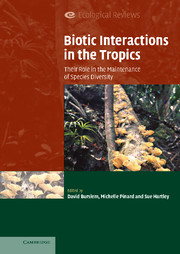Book contents
- Frontmatter
- Contents
- List of contributors
- Preface
- PART I Plant–plant interactions
- PART II Plant–microbe interactions
- PART III Plant–animal interactions
- 10 Implications of plant spatial distribution for pollination and seed production
- 11 Seed dispersal of woody plants in tropical forests: concepts, examples and future directions
- 12 The role of trophic interactions in community initiation, maintenance and degradation
- 13 Impacts of herbivores on tropical plant diversity
- 14 Have the impacts of insect herbivores on the growth of tropical tree seedlings been underestimated?
- 15 Multi-trophic interactions and biodiversity: beetles, ants, caterpillars and plants
- 16 The trophic structure of tropical ant–plant–herbivore interactions: community consequences and coevolutionary dynamics
- 17 Multitrophic interactions in a neotropical savanna: ant–hemipteran systems, associated insect herbivores and a host plant
- PART IV Biotic interactions in human-dominated landscapes
- Index
- References
11 - Seed dispersal of woody plants in tropical forests: concepts, examples and future directions
Published online by Cambridge University Press: 25 August 2009
- Frontmatter
- Contents
- List of contributors
- Preface
- PART I Plant–plant interactions
- PART II Plant–microbe interactions
- PART III Plant–animal interactions
- 10 Implications of plant spatial distribution for pollination and seed production
- 11 Seed dispersal of woody plants in tropical forests: concepts, examples and future directions
- 12 The role of trophic interactions in community initiation, maintenance and degradation
- 13 Impacts of herbivores on tropical plant diversity
- 14 Have the impacts of insect herbivores on the growth of tropical tree seedlings been underestimated?
- 15 Multi-trophic interactions and biodiversity: beetles, ants, caterpillars and plants
- 16 The trophic structure of tropical ant–plant–herbivore interactions: community consequences and coevolutionary dynamics
- 17 Multitrophic interactions in a neotropical savanna: ant–hemipteran systems, associated insect herbivores and a host plant
- PART IV Biotic interactions in human-dominated landscapes
- Index
- References
Summary
Introduction
Understanding seed dispersal is critical to understanding plant population and community dynamics (Nathan & Muller-Landau 2000), especially in tropical forests where seed rain of virtually all plant species is sparse and patchy (Hubbell et al. 1999; Muller-Landau et al. 2002). Seed rain determines potential population growth rates and spatial patterns, as well as the relative influences of post-dispersal processes such as seed predation (e.g. Wright et al. 2000), microhabitat requirements for establishment (e.g. Svenning 1999) and density-dependent survival (e.g. Harms et al. 2000). Despite its importance, we know very little about seed dispersal of tropical trees, because it has been studied in only a tiny proportion of the many tropical tree species and seed dispersers, and because the patterns that have been observed have largely eluded easy generalization.
Just as there is a greater diversity of plant species and animal species in the tropics than in other regions, there is also a greater diversity of seed-dispersal strategies and patterns. Seed dispersal by animals predominates – it is the main strategy of 70%–90% of tropical forest plant species (Willson et al. 1989) – and involves a tremendous diversity of animal species and behaviours. Birds, bats, arboreal and terrestrial mammals (everything from mice to elephants), ants, dung beetles, even fish can disperse seeds (Levey et al. 1994). Animals may consume fruit and drop, spit or defecate the seeds, carry seeds in their coats or scatter-hoard seeds for later consumption.
- Type
- Chapter
- Information
- Biotic Interactions in the TropicsTheir Role in the Maintenance of Species Diversity, pp. 267 - 309Publisher: Cambridge University PressPrint publication year: 2005
References
- 68
- Cited by

